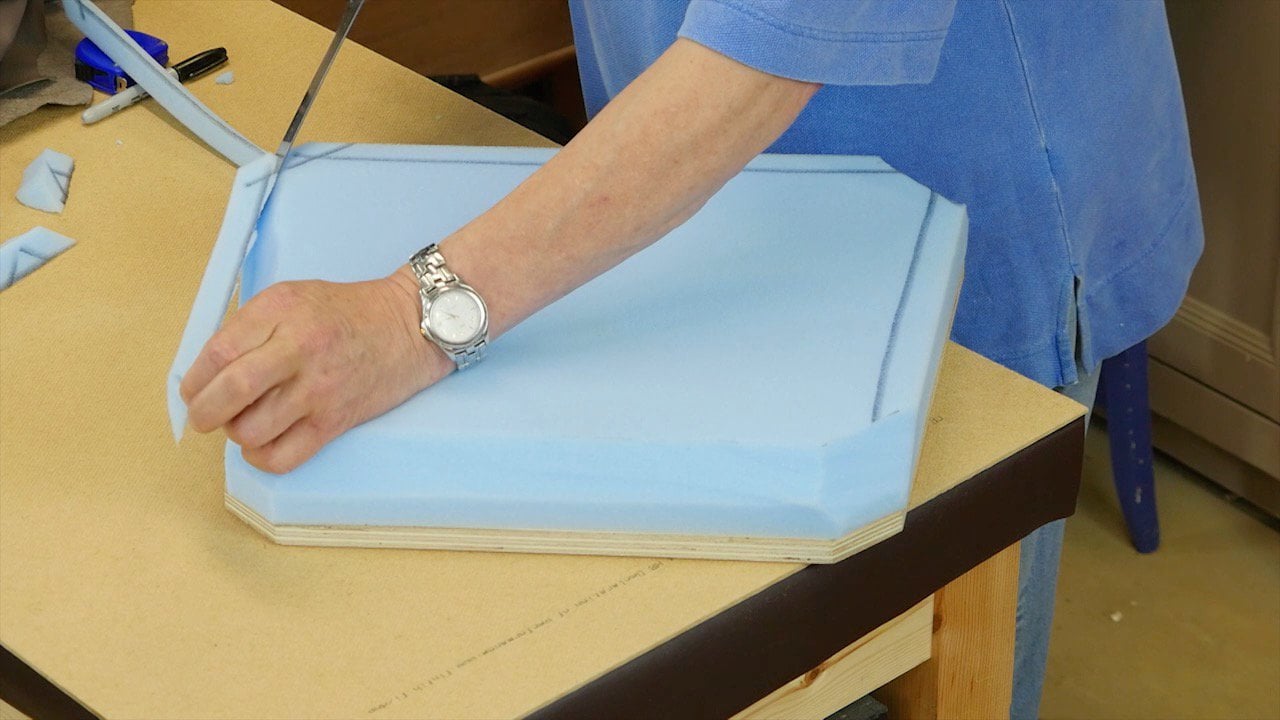Upholstery Episode 1
Posted 7 October 2015
This is an episode in a free series. Want to watch it? It is free to do so, you just need to log into the site, and you can enjoy this video and many other videos we think you will love.
For this method of upholstery, the first step is to cut a piece of plywood to fit into the recess with a small even gap around every side. He removes all the hard edges and bores the holes to allow air escape before cutting the foam to fit. With the prep done Paul cuts the leather to the approximate size.


Nice video, but I think your tolerances might be unnecessarily tight?. ( You could easily leave a bit more clearance all the way around, with less risk of pinching the leather cover at assembly). Also, using cardboard to make the initial seat pattern might simplify fitting the plywood, esp if you had to do multiple chairs. Multi prong T-nuts and ¼ or 5/16 inch bolts are the typical way these seats are installed in factory made chairs. Great camera work as usual and thank you for the lesson.
Great video, looking forward to the next ,great way for the amateur to learn how to finish of a good project, thanks Paul and the gang.
Perhaps I missed this, but Is there any particular weight/grade/kind of leather that is suitable for upholstery for seats? What should we be looking for?
many thanks,
SV
good question
Good question! I also laughed a little when he said “Leather isn’t expensive, not for this” when I looked a few weeks ago I struggled to find anything that was a reasonable price to play with. I must be looking in the wrong places!
I’d love to know where Paul got his leather, and more importantly, what he asked for.
This one seemed affordable: http://www.amazon.com/dp/B00MVJ3D34 – the 10 ft^2 should be enough for covering 3 seats or so (you may need to call the seller to get a 2’x5′ hide – they seem accommodating that way). That works out to about 20$/chair for the leather.
Depending on what you want, fabric would cost about 15-20$/yard (= 15ft^2) (working off my less than perfect memory of prices at Michael’s), so around 5-7$/chair.
I buy my hides on eBay and can buy a good upholstery hide for about £120 which gives me 6-8 seats. A full hide is about 50 square feet. You can usually buy half a hide or a single seat size too. In the USA go to Abe’s leather or go online again. Abe has all his hides on eBay too. Very nice leather.
Thank you for the lesson.
I too am quite interested in knowing where Paul purchases his inexpensive leather! I guess the process would be the same if one decided to use fabric as a substitute?
Very informative as usual.
Thank you Paul & your team
bob
hi Paul great video, I like your straight edge can you show a close up and a brief description in the next episode please.
I’ve just realized the next episode as probably already been filmed, so maybe you can show it in a future video.
Anything special to watch out for when getting this foam? I hear 2″ but I doubt all foam is created equal in compression and rebound etc…
Medium to hard density. I bought mine from Dunelm Mill in this case.
I am at the upholstery stage, and also wonder what weight leather I should be looking for. One local gentleman suggested 3-4 oz would be fine. When I felt it I wasn’t sure it was heavy enough.
Does Paul have any suggestions?
Dan
A bit different from what I practiced from years ago.
But as always, “Paul’s twist” make it some nice detail upgrade to my practice. 🙂
Thank You for that!
Wouldn’t it be easier to make a paper template first? That way the cuts can be optimised and less leather is wasted. A template made from an old newspaper would do. That is how my mom used to do it.
Why not measured the angles, cut it out in cardboard. and round the corners with a can of the right diameter, cut them of with a fret saw?
Great video with simple neat lines to provide a clean looking seat. I have reupholstered a number of chairs and always found the tight corners to be the messiest part.
Can’t wait for episode 2